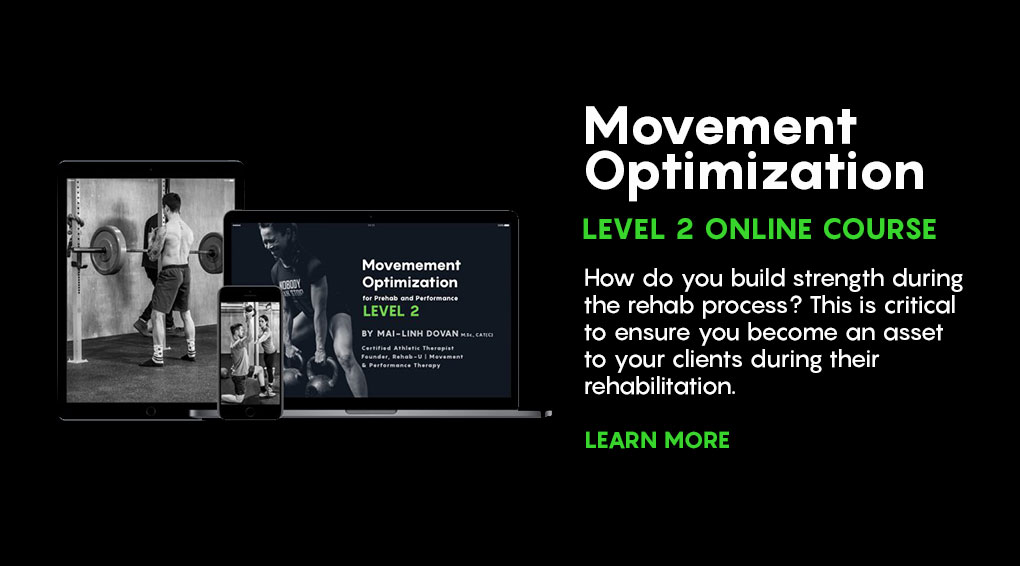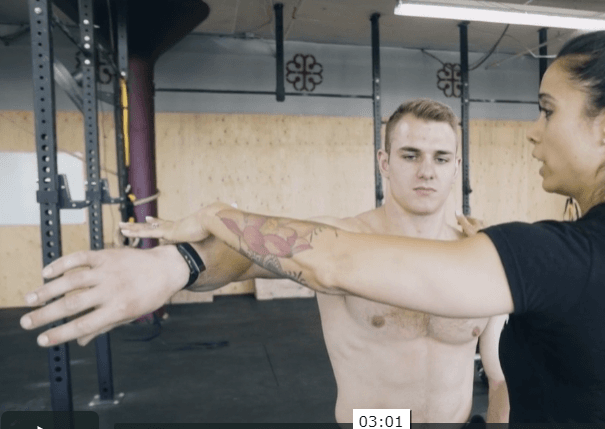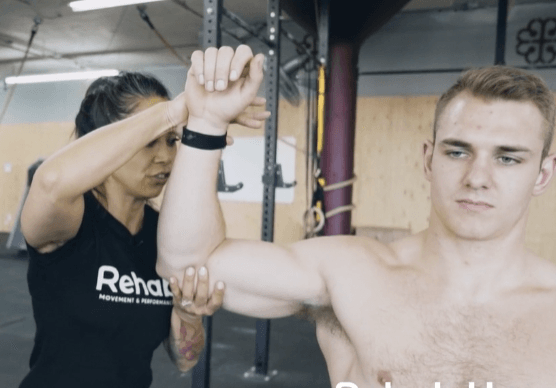
What do you do for rotator cuff pain? That’s another question I get along with “What are the best exercises for rotator cuff pain?”, which I’ll get to in my next blog article. The answer is that it depends on which of the rotator cuff muscles is irritable.
An effective intervention for an irritable supraspinatus tendon should look different than that for an irritable subscapularis tendon
There are two important components, then, to intervening more efficiently on rotator cuff pain. First is understanding the function of each of the rotator cuff muscles so that you can specifically and accurately adjust the training load and modify exercises to support the rehab process. The second is being able to identify the pain triggers which will help you identify which muscle is more likely irritable. Both of these should be part of your rotator cuff pain assessment.
If either of these two is missing, you’ll probably also miss the target, which is helping your clients move without pain.
INDIVIDUAL ROTATOR CUFF MUSCLE FUNCTIONS
The rotator cuff is composed of four different muscles. Together, these muscles function to stabilize the humeral head within the glenoid fossa during upper extremity movement. Although they are commonly visualized as “external rotators”, the largest and strongest muscle of the cuff, the subscapularis, is actually a powerful internal rotator, whereas the main action of the supraspinatus is not in external rotation.
This is the reason why the classic external rotation exercise that is often generically prescribed for everything rotator cuff related is usually a hit or miss
While together the muscles of the cuff have a stabilization role for the glenohumeral joint, individually they have important functions for various movements involving the upper extremity. These are important to take into consideration when looking to avoid pain triggers or to avoid overloading a tendon that has decreased tolerance.
Supraspinatus
The supraspinatus assists in the first 15 degrees of abduction, where it is the main agonist. In fact, it is thought to be instrumental in the initiation of abduction. As such, it acts strongly when a heavy weight is carried by the side. It also acts to resist the strong superior force exerted by the deltoid on the humeral head.
Movements that place the arm in abduction, and even in forward flexion, are typically not well tolerated with supraspinatus irritation. Initially, consider modifying exercise to avoid reaching, abduction and overhead movements. For example, bent-over rows might be more tolerable than seated rows, because the weight of the arm is in an anti-gravity position.
Since the supraspinatus is highly solicited with heavy carries, you may need to avoid these initially. They also cause compression of the tendon on the greater tuberosity, and tendons typically don’t like compression.
Subscapularis
The subscapularis is a very powerful internal rotator, but perhaps its most important function is to provide anterior stability of the glenohumeral joint, particularly from 0 to 45 degrees of abduction. It also acts to prevent superior migration of the humeral head.
Movements that require a strong internal rotation force, as well as movements that require preventing the humeral head from gliding anteriorly are likely to be irritable. For example, you will find that bench presses and horizontal rows with a pronated grip are not well tolerated. Think of substituting these with different grips and or temporarily decreasing the range of motion.
Infraspinatus and Teres Minor
The infraspinatus and teres minor are the primary external rotators of the glenohumeral joint. Movements that require reaching or overhead work are typically not well-tolerated. Consider using pushing and pulling movements that keep the elbows tucked in close to the sides, as these are usually better tolerated.
DIFFERENTIATING THE MUSCLES OF THE CUFF
I always like to preface with the reiteration that the information provided in this article should not be used as a substitute for, nor does it replace, professional health care advice, diagnosis, or treatment; nor should it be taken to be the practice or education of medical care. As a professional, you should adhere to the provisions of your respective scope of practice and act in accordance with these.
Now that that’s out of the way, let’s discuss the importance of differentiating the muscles of the rotator cuff.
In the clinic, we use special tests, or provocative tests, as part of an overall assessment. It is worth noting that no special test is 100% reliable, valid, sensitive or specific. They can be suggestive of a condition when they yield positive results but can also yield false positives. As well, because there is a certain interdigitation of the rotator cuff tendon, the individual could present with pain on more than one of these tests.
The idea is that, along with the client’s subjective input on movements that trigger pain (in activities of daily living as well as in training) differentiating the muscles of the cuff as best as you can will point you in the right direction so that 1) you avoid overloading a tendon who’s capacity has already been surpassed and 2) you select the “best” rotator cuff exercises for that individual.
Supraspinatus
The Empty Can Test is the most commonly used assessment test for supraspinatus impingement or integrity of the supraspinatus muscle or tendon. Position the arm at 90 degrees of abduction in the plane of the scapula (30 to 45 degrees from the frontal plane) and in full internal rotation, thumb pointing down. It is meant to look like they are emptying a beverage can, hence the name. Apply downward pressure and have the individual resist. Technically the test is considered positive if the individual gives way and is unable to resist the downward pressure. The supraspinatus muscle or tendon may be irritable if there is weakness and/or pain, or if the individual can resist pressure but doing so recreates their pain. Pain is typically located on the top of front of the shoulder and/or lateral shoulder (deltoid area).
Subscapularis
A common test for integrity of the subscapularis muscle or tendon is the lift-off test. This test is quite simple. The individual is asked to place the dorsum (back) of the hand against the lower back and then lift the hand away from the back. The inability to lift the hand would indicate a positive test. The subscapularis muscle or tendon may be irritable if lifting off the hand recreates the individual’s pain. Pain is typically located in the front of the shoulder, near the bicipital groove.
Infraspinatus and Teres Minor
Together, the infraspinatus and teres minor are the main external rotators of the glenohumeral joint. They are often tested together using Hornblower’s sign, which we will discuss next. A common test for the infraspinatus muscle is resisted external rotation at zero degrees of abduction.
Hornblower’s sign is performed at 90 degrees of abduction in the scapular plane. The individual is asked to perform resisted external rotation.
Both of these tests would be considered positive if the individual was unable to perform external rotation. The infraspinatus and or teres minor might be irritable if they are able to perform external rotation but it reproduces their pain. Pain is typically located in the back of the shoulder just under the acromion.
Make sure to watch the full video of this article to see how these tests are done.
BETTER IDEA, MORE OPTIMAL INTERVENTION
So, what do you do for rotator cuff pain? The first step is always assessing to get a better idea of what exactly you are dealing with. As I mentioned earlier, none of these tests are 100% reliable, valid, sensitive or specific. Dr. Karel Lewit said “We work at a level of acceptable uncertainty.”
Differentiating the muscles of the cuff and assessing the specific movements that trigger an individual’s pain helps establish a certain level of certainty as to how your rehab training plan needs to be built and what type of movements need to be temporarily avoided, replaced or modified so we don’t continue to exceed the tissue’s tolerance to load.
We need to do a better job than to prescribe and external rotation exercise and provide clients with a list of movements to avoid. We need to provide structure to seamlessly integrate rehab into the training process, with the right interventions and modifications, to get our clients from injured to strong. In next week’s article, we will discuss how to select rotator cuff exercises more efficiently based on what we now know.

Mai-Linh Dovan M.SC., CAT(C)
Certified Athletic Therapist
Founder of Rehab-U










Be part of the conversation